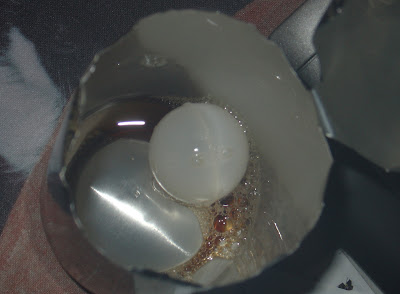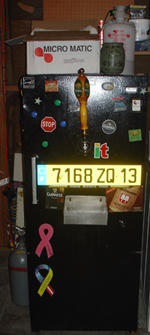I was asked which is a better beer, Guinness or Heineken? Having drank a lot of both and having gone to both breweries and having bought a keg of each I can't say which is better. What I can say is what some of the factors are which separate Guinness from Heineken and most ever other beer for better or worse.
Consider Guinness Draught to be more complex and distinctive beer while at the same time not necessarily being the better beer. Take into consideration the unique dispensing style of Guinness Draught using a stout faucet vs  the standard beer faucet. The way the creamy foam head forms as the nitrogen bubbles dissolve out of the beer and creating a cascading effect in which the bubbles appear to be falling within the glass. This is often referred to as the "surge" which you have to wait to complete before one can finish with the second part of the famous two part pour. This is the result of the beer being nitrogenized. Meaning the gas used to carbonate the beer is a combination of nitrogen and CO2. In fact the ratio is 75% nitrogen and 25% CO2. This combination is often referred to as Guinness Gas or Bev Gas in the industry. Guinness is also kept under a much high pressure then Hieneken (30-40 psi vs 10-14 psi). This is because the nitrogen gas has a lower affinity for the beer and must be a high pressure in order to dissolve into the Guinness. This is the same principal behind the bends which effect deep water divers. Were at high pressure and deeper depths the nitrogen dissolves into the blood. When the pressure is released as the diver approaches the surface nitrogen forms tiny bubbles in the blood which cause health problems. This is essentially the same thing that is happening in a can of Guinness Draught but you want this to happen in a can of Guinness Draught.
the standard beer faucet. The way the creamy foam head forms as the nitrogen bubbles dissolve out of the beer and creating a cascading effect in which the bubbles appear to be falling within the glass. This is often referred to as the "surge" which you have to wait to complete before one can finish with the second part of the famous two part pour. This is the result of the beer being nitrogenized. Meaning the gas used to carbonate the beer is a combination of nitrogen and CO2. In fact the ratio is 75% nitrogen and 25% CO2. This combination is often referred to as Guinness Gas or Bev Gas in the industry. Guinness is also kept under a much high pressure then Hieneken (30-40 psi vs 10-14 psi). This is because the nitrogen gas has a lower affinity for the beer and must be a high pressure in order to dissolve into the Guinness. This is the same principal behind the bends which effect deep water divers. Were at high pressure and deeper depths the nitrogen dissolves into the blood. When the pressure is released as the diver approaches the surface nitrogen forms tiny bubbles in the blood which cause health problems. This is essentially the same thing that is happening in a can of Guinness Draught but you want this to happen in a can of Guinness Draught.
 If you have can or bottle of Guinness Draught you may have noticed there is something in the can. You weren't going crazy there is something in the can and it is called a widget. This widget is a small plastic container with a tiny hole in it. During the bottling process just after the beer is added to the bottle or can a small amount of liquid nitrogen and CO2 is added. This mix of gases is sealed inside of the bottle or can. Where over a period of time (most likely a few days) the gases dissolve into the beer. Being that the bottle or can is under pressure, beer and dissolved nitrogen and CO2 is forced into the widget until the pressure inside the widget is in equilibrium with the pressure of the inside of the can. When you crack the can or open the bottle the pressure is release inside of the can or bottle. When this happens the beer still inside the widget is forced out of the tiny hole into the can or bottle. This accelerates the formation of nitrogen bubbles and helps to generate the head and produce the surge Guinness Draught is known the world around for. Without the widget the nitrogen would still bubble out of the beer, but at a much slower rate and a quality layer of head on the top of the pint would not be formed.
If you have can or bottle of Guinness Draught you may have noticed there is something in the can. You weren't going crazy there is something in the can and it is called a widget. This widget is a small plastic container with a tiny hole in it. During the bottling process just after the beer is added to the bottle or can a small amount of liquid nitrogen and CO2 is added. This mix of gases is sealed inside of the bottle or can. Where over a period of time (most likely a few days) the gases dissolve into the beer. Being that the bottle or can is under pressure, beer and dissolved nitrogen and CO2 is forced into the widget until the pressure inside the widget is in equilibrium with the pressure of the inside of the can. When you crack the can or open the bottle the pressure is release inside of the can or bottle. When this happens the beer still inside the widget is forced out of the tiny hole into the can or bottle. This accelerates the formation of nitrogen bubbles and helps to generate the head and produce the surge Guinness Draught is known the world around for. Without the widget the nitrogen would still bubble out of the beer, but at a much slower rate and a quality layer of head on the top of the pint would not be formed.
 Interestingly enough the same principle is used when dispensing Guinness Draught from a keg. Inside of a stout faucet is a small metal plate with eight or so tiny holes through which the beer is forced as it is dispensed into the glass. These tiny holes force the nitrogen out of the beer just as with the widget to produce the cascading "surge" effect and proper amount of head. This is of course assuming you poured the pint correctly.
Interestingly enough the same principle is used when dispensing Guinness Draught from a keg. Inside of a stout faucet is a small metal plate with eight or so tiny holes through which the beer is forced as it is dispensed into the glass. These tiny holes force the nitrogen out of the beer just as with the widget to produce the cascading "surge" effect and proper amount of head. This is of course assuming you poured the pint correctly.
Pouring a pint of Guinness Draught is a two part operation and it can't be rushed. It should take about two minutes to pour a pint of Guinness. I recommend watching the following short video which effectively demonstrates how to pour a pint of Guinness, http://videos.howstuffworks.com/howstuffworks/41-how-to-pour-a-guinness-video.htm
Many consider Guinness to be a heavy beer. Guinness is generally considered to contain 210 calories per pint. Compare to a pint of orange juice (220 calories) or a pint of skim milk (260 calories.) The nitrogen may help contribute to the different mouth feel Guinness Draught along with other components of the beer whose contribution I don't fully understand as I am not a food sensory scientist.
These are just some of the reasons why I feel Guinness is such a great beer. Honestly I feel you can't compare Heineken to Guinness, consider their differences, Heineken is a lager style beer were Guinness Draught is considered an type of ale. This means both of these beer are fermented by two different kinds of yeast at different temperatures and for different periods of time. The fact both beers are brewed and dispensed completely differently makes them almost polar opposites of each other. These are beers which can't be compared side by side. One can say they prefer one over the other but there is no way one can say one is better then the other. How could one say an apple is better then an orange?





1 comment:
Jeff,
I recently had a guy at a beverage distributor tell me that you could run all kegs, regardless of the kind of beer on "bev gas" or the nitrogen/CO2 mix normally used for Guinness. He said that it would actually help keep the kegs fresher for longer. I've never heard this before, and was just wondering if you had.
-Jason
Post a Comment